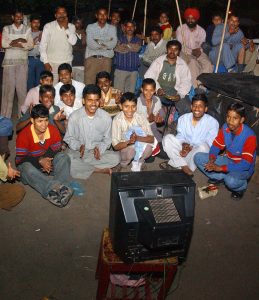In 2005, the Journal of Memetics – Evolutionary Models of Information Transmission ceased publication and published a set of articles on the future of memetics. The website states that although “there was to be a relaunch…after several years nothing has happened”.[9] Susan Blackmore has left the University of the West of England to become a freelance science-writer and now concentrates more on the field of consciousness and cognitive science. Derek Gatherer moved to work as a computer programmer in the pharmaceutical industry, although he still occasionally publishes on memetics-related matters. Richard Brodie is now climbing the world professional poker rankings. Aaron Lynch disowned the memetics community and the words “meme” and “memetics” (without disowning the ideas in his book), adopting the self-description “thought contagionist”. He died in 2005.
Susan Blackmore (2002) re-stated the definition of meme as: whatever is copied from one person to another person, whether habits, skills, songs, stories, or any other kind of information. Further she said that memes, like genes, are replicators in the sense as defined by Dawkins.[10] That is, they are information that is copied. Memes are copied by imitation, teaching and other methods. The copies are not perfect: memes are copied with variation; moreover, they compete for space in our memories and for the chance to be copied again. Only some of the variants can survive. The combination of these three elements (copies; variation; competition for survival) forms precisely the condition for Darwinian evolution, and so memes (and hence human cultures) evolve. Large groups of memes that are copied and passed on together are called co-adapted meme complexes, or memeplexes. In Blackmore’s definition, the way that a meme replicates is through imitation. This requires brain capacity to generally imitate a model or selectively imitate the model. Since the process of social learning varies from one person to another, the imitation process cannot be said to be completely imitated. The sameness of an idea may be expressed with different memes supporting it. This is to say that the mutation rate in memetic evolution is extremely high, and mutations are even possible within each and every iteration of the imitation process. It becomes very interesting when we see that a social system composed of a complex network of microinteractions exists, but at the macro level an order emerges to create culture.[citation needed]
Internalists and externalists
The memetics movement split almost immediately into two. The first group were those who wanted to stick to Dawkins’ definition of a meme as “a unit of cultural transmission“. Gibron Burchett, another memeticist responsible for helping to research and co-coin the term memetic engineering, along with Leveious Rolando and Larry Lottman, has stated that a meme can be defined, more precisely, as “a unit of cultural information that can be copied, located in the brain”. This thinking is more in line with Dawkins’ second definition of the meme in his book The Extended Phenotype. The second group wants to redefine memes as observable cultural artifacts and behaviors. However, in contrast to those two positions, Blackmore does not reject either concept of external or internal memes.[11]
These two schools became known as the “internalists” and the “externalists.” Prominent internalists included both Lynch and Brodie; the most vocal externalists included Derek Gatherer, a geneticist from Liverpool John Moores University, and William Benzon, a writer on cultural evolution and music. The main rationale for externalism was that internal brain entities are not observable, and memetics cannot advance as a science, especially a quantitative science, unless it moves its emphasis onto the directly quantifiable aspects of culture. Internalists countered with various arguments: that brain states will eventually be directly observable with advanced technology, that most cultural anthropologists agree that culture is about beliefs and not artifacts, or that artifacts cannot be replicators in the same sense as mental entities (or DNA) are replicators. The debate became so heated that a 1998 Symposium on Memetics, organised as part of the 15th International Conference on Cybernetics, passed a motion calling for an end to definitional debates. McNamara demonstrated in 2011 that functional connectivity profiling using neuroimaging tools enables the observation of the processing of internal memes, “i-memes”, in response to external “e-memes”.[12]
An advanced statement of the internalist school came in 2002 with the publication of The Electric Meme, by Robert Aunger, an anthropologist from the University of Cambridge. Aunger also organised a conference in Cambridge in 1999, at which prominent sociologists and anthropologists were able to give their assessment of the progress made in memetics to that date. This resulted in the publication of Darwinizing Culture: The Status of Memetics as a Science, edited by Aunger and with a foreword by Dennett, in 2001[13].



![Tavistock institute for human relations iu[2]](https://cognitive-liberty.online/wp-content/uploads/iu2-1-192x300.jpg)


![Academic freedom noam-chomsky[1]](https://cognitive-liberty.online/wp-content/uploads/noam-chomsky1-200x300.jpg)